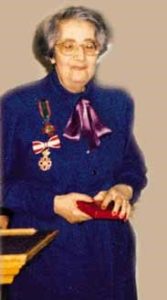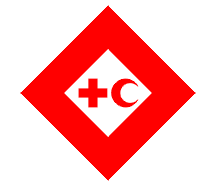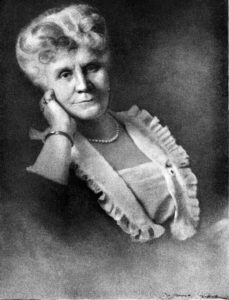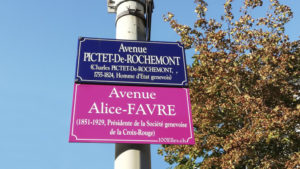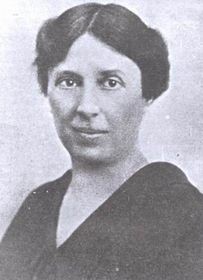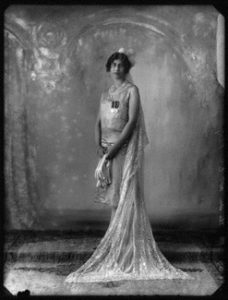Augusta – the full name was Julie Augusta Georgine – was born in Christiania 11 December 1869 and baptized[i] in the Cathedral there – the Church of our Saviour – 28 April 1870. Witnesses at the ceremony were Minister of the Crown, Stang, and his wife Mrs Ministress Stang; Professor Rasch; the Reverend[ii] I. H. Lund; Student N. Berg; Mrs. Fredrikke Berg; and Miss Sophie Pharo.
Her parents were the solicitor[iii], Emil Stang, and his wife Adeleide Pauline, nee Berg. They had married four and a half years before Augusta was born. Their wedding[iv] took place in the Church of the Trinity in Christiania 12 July 1865. Banns were read 25 June, 2 July, and 9 July. Their witnesses were their fathers: Fredrik Stang and Per A. J. Berg.
The same year, in the autumn, Augusta’s paternal grandfather founded[v] the Norwegian Red Cross
The first child of this union was a girl. Marie Henriette came into the world 31 March 1866 and baptized[vi] in the Cathedral in Christiania 3 July the same year. The witnesses were Prime Minister F. Stang; Merchant P. A. J. Berg; Solicitor P. A. Hielm; Mrs. Berg; Ministress E. Berg; and [NN] Augusta Stang.
A year and a half later, 27 December 1867, a boy arrived. He was named for his paternal grandfather, Fredrik when he was baptized[vii] in the Cathedral 4 March 1868. As witnesses the parents chose Minister Stang; Judge[viii] Morgenstierne; Chamberlaine B. Stang; Lieutenant P. O. S. Berg; Ministress Stang; Mrs Laura Lundh; and Miss Olvia Berg.
And so, it was Augusta’s turn – as the third child. The next one was also a girl. Adeleide was born 16 September 1871 and was home baptized[ix] by the doctor 30 of the same month.
The reason the doctor baptized her was, apparently, that she was very ill: she died the same day and was buried[x] 4 October. She lived only two weeks, the little one.
She was followed by another other girl who saw the light of day 30 November 1872. when she was baptized[xi] in the Cathedral 15 May the following year – she had not been baptized at home – she was named for her mother, Adelaide Pauline. The witnesses were Lieutenant Herman Stang; Lieutenant Johs. Solum; Joachim Lund; Solicitor Heffermehl; Erik Berg; Widow Marie Berg; Mrs Kathrine Hopp; and Miss Kristine Stang.
The sixth of the Stang siblings was Peder Berg. He was born 24 March 1875 and baptized[xii] in the Cathedral 10 May the same year. Peder’s witnesses were Prime Minister Fredrik Stang; Wholesaler Knud Graah; Premier Lieutenant Peter O. J. Berg; Mr Gustav Berg; Widow Marie H. Berg; [NN] Mrs. Emma Heffermehl; and Miss Agneta Lund.
In the census for 1875[xiii] – conducted in early 1876 – Augusta can be found, with her parents and siblings, in an apartment in Prinsens Gade 3a in Christiania, not far from the main railway station. Her father is listed as solicitor, her mother housewife. Her two brothers and two sisters are there, too: Marie Henriette (10); Fredrik (8); Adeleide Pauline (3); and Peder Berg (1). The three servants were all women – Frederikke Elise Kynell from Larvik (30); Kristine Kristiansen from Romedal (24); and Petra Vetlesen from Nesodden (24).
Two years later, 9 October 1877, the little sister Emilie was born. When she was baptized[xiv] 2 December the same year the ceremony was witnessed by Mrs Jakobine Stang; Prime Minister F. Stang; Sorenskriver Kristian Frisch; [NN]-doctor [NN] [NN]; Mrs J. Augusta G. Stang, n. Morgenstierne; and Mrs [NN] [NN] n. Morgenstierne.
Emilie died as a small child on 10 April 1878. The cause was a lung-infection. She was buried[xv] three days later.
Augusta’s youngest brother, Emil, announced his arrival 22 September 1882. He was baptized[xvi] 10 November the same year, and the witnesses were Prime Minister Fr. Stang; the National Archivist Birkeland; Premier Lieutenant Alexis von Munthe af Morgenstjerne; Student Emil Stang Lund; Marie Berg; Mrs Christine Berg; and Miss Marie Stang.
Emil, like his father and grandfather, and like Augusta herself, became politically active – but in opposition to the family he was first a socialist, then a communist and participated in the First International, and a journalist and lawyer who ended up as a Supreme Court Justice after the Second World War[xvii].
When Augusta was around 15, her paternal grandfather died. His life ended 8 June 1884 and was buried Thursday 12 the same month, with the ceremony[xviii] taking place in the Church of the Trinity at 2:15 in the afternoon.
A year later, in 1885[xix], there was another census. In this Augusta – with no more given names – is found with her parents in an apartment in Grev Wedels Plass 5. Of the other children, Marie (19); Fredrik (18); Adeleide (13); Peder (10); and Emil (3) are present.
The servants include Elise Fredrikke Kynell (39) – most probably the same as in 1875, even if the order of the given names has been altered – Bredine Olsen (31) from Laurdal; and Sophie Christensen (27) from Eker.
Some years passed, and the family had moved to a new house: now to Raadhusgade, house number 19. That is where one finds Augusta in 1891[xx], together with her parents. She is a bit difficult to find in the census material, for the transcriber has misinterpreted the family name as “Steng”.
Many of the siblings are still with their parents. And a number of servants: now also a male one – Jens Kristian Johannesen Hauger, a 29-year old man from Drøbak; but also several female ones: Hanna Matilde Olsen (30) from Eidsvold; Henriette Karoline Halvorsen (27) from Drammen; Dina Dahl (33) from Nittedal; and the ever-present Lise Fredrike Kynnell (45) from Larvik.
Augusta was enrolled at Nissen’s Pikeskole – a girls’ school in one of the better districts of Christiania and graduated from there in 1896[xxi] with a teacher’s certificate. She then began working at Frogner School, also in the west end of the city.
In 1900[xxii], Augusta has left her parent’s household. During the census of this year she is found at the Holmenkollen Sanatorium, currently a hotel. By occupation she is still teacher, and she has remained unmarried.
The same year she published a book for children: Til arbeide og lek. Haandbok for gutter og piker – «For work and play. A Handbook for Boys and Girls”.
In 1905 she appears to have quit her teaching job for, over the next years, a free-lance life of writing and translating.
In 1906 Augusta, together with her sister Adelaide and someone called Yngvar Brun, published a “reading book” for school children.
In 1909 she appears as the translator[xxiii] of a German work by A. L. Grimm, Stories from the Heroic Age of the Greeks and Romans, adapted for Youth.
Ten years later, in 1910[xxiv], she is back with her – now retired – parents in an apartment on the third floor of Nobel’s Street 18 in Kristiania. The teaching career seems to have petered out: she is listed as having no occupation. Her sister Marie, too, lives there – but has a job as an assistant in the national insurance service. With a smaller family they had reduced the number of servants to two: 26-year old Thora Halvorsen from Drammen and the three years younger Agnes Jacobsen from Sem.
Two years later Augusta lost her father. Emil Stang died, 78 years old, 4 July 1912. The funeral[xxv] took place at the graveyard of Our Saviour Church 8 July, but the record of this has not been found.
The same year she appears as translator of a book[xxvi] by Howard Pyle, in Norwegian called “Squire and Knight”.
With her father gone, living at home was probably impractical, for the same year she start working for Aftenposten, a Kristiania newspaper of a conservative persuasion.
Here she edited the column “For the Little Ones”, and initiated the newspaper’s annual fundraising campaign, the Argus campaign.
She was, increasingly, active in politics. First at the municipal level: she was member of the council of Christiania – Oslo from 1925 – during the period 1920-31. From 1931[xxvii] to 1933 she was the second female member of parliament for the Conservative Party, whose Women’s Organisation she chaired for ten years until 1937.
In 1920, Augusta represented the Norwegian Red Cross at the first conference of the League of Red Cross Societies, which took place in Geneva 2-8 March 1920.
Her interests were focussed on the welfare of children, and for that reason she participated in the “International Conference on the Treatment of Women and Children[xxviii]” which took place in Geneva 30 June to 5 July 1921, at which she represented the Norwegian Red Cross.
Augusta’s parliamentary career was short, in 1933 she was deselected[xxix] by the Conservative Party in Oslo and replaced by Mrs Gulla Grundt.
Augusta died in 1944, around 75 years old. The funerals are not available for this year.
_______________________________________
[i] SAO, Oslo domkirke Kirkebøker, F/Fa/L0017: Ministerialbok nr. 17, 1869-1878, s. 76
Brukslenke for sidevisning: https://www.digitalarkivet.no/kb20060216011045
[ii] In the original «Res. kapellan», a sort of junior vicar, often in charge of a subsidiary church and congregation.
[iii] The term used is «Høyesterettsadvokat», a lawyer who has won the right to plead a case before the Supreme Court of Norway.
[iv] SAO, Trefoldighet prestekontor Kirkebøker, F/Fc/L0001: Ministerialbok nr. III 1, 1858-1874, s. 162
Brukslenke for sidevisning: https://www.digitalarkivet.no/kb20060213040508
[v] https://en.wikipedia.org/wiki/Norwegian_Red_Cross
[vi] SAO, Oslo domkirke Kirkebøker, F/Fa/L0016: Ministerialbok nr. 16, 1863-1871, s. 175
Brukslenke for sidevisning: https://www.digitalarkivet.no/kb20060216010777
[vii] SAO, Oslo domkirke Kirkebøker, F/Fa/L0016: Ministerialbok nr. 16, 1863-1871, s. 275
Brukslenke for sidevisning: https://www.digitalarkivet.no/kb20060216010878
[viii] The term used is «sorenskriver», literally “sworn scribe” a legal official appointed by the Crown.
[ix] SAO, Oslo domkirke Kirkebøker, F/Fa/L0017: Ministerialbok nr. 17, 1869-1878, s. 171
Brukslenke for sidevisning: https://www.digitalarkivet.no/kb20060216011141
[x] SAO, Oslo domkirke Kirkebøker, F/Fa/L0026: Ministerialbok nr. 26, 1867-1884, s. 62
Brukslenke for sidevisning: https://www.digitalarkivet.no/kb20060215020584
[xi] SAO, Oslo domkirke Kirkebøker, F/Fa/L0017: Ministerialbok nr. 17, 1869-1878, s. 278
Brukslenke for sidevisning: https://www.digitalarkivet.no/kb20060216011248
[xii] SAO, Oslo domkirke Kirkebøker, F/Fa/L0017: Ministerialbok nr. 17, 1869-1878, s. 419
Brukslenke for sidevisning: https://www.digitalarkivet.no/kb20060216011391
[xiii] Folketelling 1875 for 0301 Kristiania kjøpstad, https://www.digitalarkivet.no/census/person/pf01052055005191
[xiv] SAO, Oslo domkirke Kirkebøker, F/Fa/L0017: Ministerialbok nr. 17, 1869-1878, s. 526
Brukslenke for sidevisning: https://www.digitalarkivet.no/kb20060216011502
[xv] SAO, Oslo domkirke Kirkebøker, F/Fa/L0026: Ministerialbok nr. 26, 1867-1884, s. 176
Brukslenke for sidevisning: https://www.digitalarkivet.no/kb20060215020701
[xvi] SAO, Oslo domkirke Kirkebøker, F/Fa/L0029: Ministerialbok nr. 29, 1879-1892, s. 94
Brukslenke for sidevisning: https://www.digitalarkivet.no/kb20060921070430
[xvii] Haffner, Vilhelm; Stortinget og statsrådet : 1915-1945. B. 1 : Biografier : med tillegg til Tallak Lindstøl: Stortinget og Statsraadet 1814-1914; Oslo:[Aschehoug], 1949; pp 559-660; https://urn.nb.no/URN:NBN:no-nb_digibok_2007060100024
[xviii] Aftenposten; 10.06.1884; https://urn.nb.no/URN:NBN:no-nb_digavis_aftenposten_null_null_18840610_25_132_1
[xix] Folketelling 1885 for 0301 Kristiania kjøpstad, https://www.digitalarkivet.no/census/person/pf01053257006885
[xx] Folketelling 1891 for 0301 Kristiania kjøpstad, https://www.digitalarkivet.no/census/person/pf01052721058360
[xxi] Haffner, Vilhelm; Stortinget og statsrådet : 1915-1945. B. 1 : Biografier : med tillegg til Tallak Lindstøl: Stortinget og Statsraadet 1814-1914; Oslo:[Aschehoug], 1949; p 660; https://urn.nb.no/URN:NBN:no-nb_digibok_2007060100024
[xxii] Folketelling 1900 for 0218 Aker herred; https://www.digitalarkivet.no/census/person/pf01037028017603
[xxiii] Fischer, Karl; Katalog over bøker skikket for folkeboksamlinger : hovedkatalog 1909 med register; Kristiania, 1909; P 13; https://urn.nb.no/URN:NBN:no-nb_digibok_2012081424001
[xxiv] Folketelling 1910 for 0301 Kristiania kjøpstad; https://www.digitalarkivet.no/census/person/pf01036392089173
[xxv] Aftenposten; 05.07.1912; https://urn.nb.no/URN:NBN:no-nb_digavis_aftenposten_null_null_19120705_53_335_2
[xxvi] Pyle, Howard|Stang, Augusta; Væbner og ridder; Kristiania, 1912; https://urn.nb.no/URN:NBN:no-nb_digibok_2012081508178
[xxvii] Smaalenenes Social-Demokrat; 22.10.1930; https://urn.nb.no/URN:NBN:no-nb_digavis_smaalenenessocialdemokrat_null_null_19301022_15_245_1
[xxviii] http://www.indiana.edu/~league/conferencedata.htm
[xxix] Smaalenenes Social-Demokrat; 02.09.1933; https://urn.nb.no/URN:NBN:no-nb_digavis_smaalenenessocialdemokrat_null_null_19330902_28_202_1
